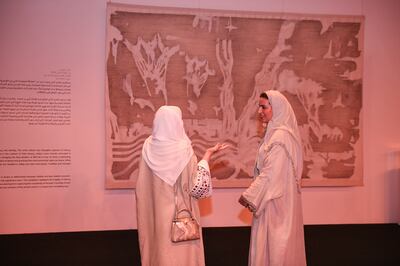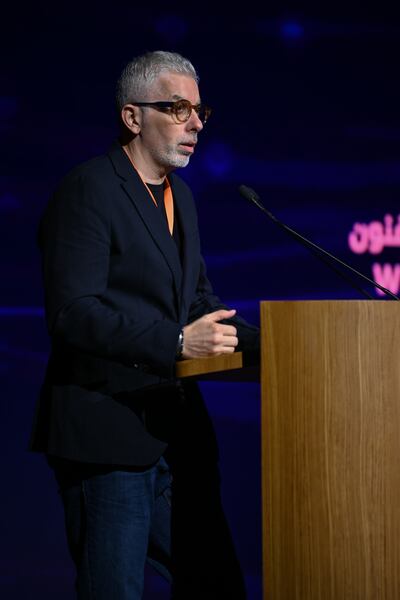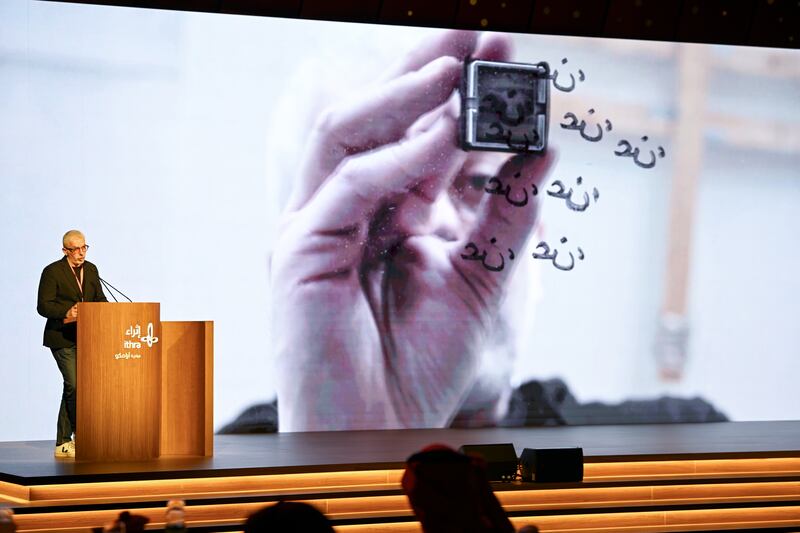In a grand ceremony last week, the fifth Ithra Art Prize unveiled the winning artwork On (Aan in Arabic) by Iraqi-Finnish artist Adel Abidin, displaying his large-scale mural, which draws together threads of selective memory, the fallibility of history and lost oral storytelling traditions.
Selected from over 10,000 submissions by an independent jury, Abidin was awarded $100,000, in addition to the full funding required to bring his project to life, making this the largest art grant in the region. The work will now join Ithra’s permanent collection.
The unveiling took place at the King Abdulaziz Centre for World Culture, commonly known as Ithra, in Dhahran, Saudi Arabia, for the first time since the prize’s launch in 2017. To mark the occasion, all previous prize winners’ works are being exhibited around Ithra, paying homage to a programme that has grown from only supporting local talent to accepting submissions from across the Arab world.
Previous winners include Saudi’s Ayman Zedani (2018), Daniah Al Saleh (2019) and Fahad bin Naif (2020) and Tunisian-Ukrainian artist Nadia Kaabi-Linke (2021).

“We are delighted to unveil Adel Abidin’s work alongside the previous Ithra Art Prize winners, to showcase the leading contemporary artists who have been recognised by the Ithra Art Prize, and reflect on its increasing influence since its inception,” Ithra head of museums Farah Abushullaih says. “We're very proud to have him as part of our production.”
The winning work is based on a year’s worth of research into the Zanj rebellion of 869 AD against the Abbasid Caliphate in Basra in Iraq. The mural aims to question the accuracy of recorded history and tries to lend a voice to overlooked or unrecorded stories lost to time.
“Their aim of the rebellion was to free slaves and seek social justice, which interested me, so I dug deeper and noticed that most of what I was reading is all rewritten accounts,” Abidin tells The National, “based on the word of someone else, who heard the news from someone else – like Chinese whispers – and it would say ‘Aan,’ in Arabic, [roughly translating to ‘on the authority or account of…’] this or that person.
“It's an old way of oral storytelling and whenever I read a passage with Aan, I liked that it gives history this intangible, vulnerable aspect,” he adds. “I wanted to create a single piece that really represented the feeling I got when doing this research, this fragility of history.”

The resulting mural is made of thin Japanese rice paper layered with starchy glue, with a repeated stamp of the word Aan used to form a surreal, abstract image of Basra, with the Tigris and Euphrates rivers flowing over the city based on scenes Abidin imagines while reading the stories.
Each stamp represents the different, even contradictory, versions of the rebellion’s history, leaving it open to the viewer to interpret and form their own opinion of what might have happened. The many layers of paper and overlapping stamps also allude to the depth of history and its many mysteries.
“Since everything hinged on that one Arabic work, my idea was to give every story or version I found the right amount of account in this new retelling I was recounting. To make me a new storyteller of the whole event,” Abidin says. “This resonates with the stress of the stamping – if you stamp hard you get a strong ink imprint or if used lightly it leaves only a trace.
“History is always alive, and what we are reading could all be fake and we wouldn’t know, because history is always written by the victors, so the only thing we read is one side of the story,” he adds. “We don't have anything written by the Zanj, so we will never know their side of history. I started thinking in their shoes, how they reacted and how I could start creating their own identity in the story.”

This medium is new to Abidin, who is usually known for his work with video, and he intends to explore the technique further in a larger body of work. To create the mural, he sought instruction on working with rice paper and even learnt to cook starch glue at home.
Using On as a starting point, his upcoming exhibition in Helsinki next March will expand on his research and use the stamping method to create new works, alongside sketches, sculptures and video pieces inspired by the text about the Zanj rebellion, contrasted with contemporary elements.
“It was a really big challenge but I went with it. It took a lot of time to get this technique right so I don’t want to let it go until I get everything I can out of it,” he says. “I've really fallen in love with this technique, even though it stressed me a lot in the beginning, but winning this prize really gave me the push to do it and pushed me outside my comfort zone, so I want to explore it further.”
In August, Ithra announced their open call for the sixth Ithra Art Prize – ending September 30 – which will be a special edition created in partnership with the Royal Commission of AlUla. Under the theme of The Art of The landscape, it seeks submissions for public artwork proposals that are site-specific to AlUla and that present interpretations of the region’s unique landscapes and natural heritage.
The winning piece will then be unveiled as a part of the AlUla Arts Festival on February 8, and will be exhibited in the AlUla Oasis for six weeks before joining Ithra’s permanent collection.
“Both Ithra and RCU have a long-standing commitment to providing enriching opportunities to artists in the region in order to propel our growing creative economy,” Ithra manager of programmes Noura Alzamil says.
“We are truly honoured to launch the sixth Ithra Art Prize in collaboration with RCU, encouraging artists to reflect Saudi Arabia’s outstanding natural heritage in their work and we look forward to uniting our efforts to support culture, art and creativity across the Kingdom and beyond, as part of our wider strategic partnership with RCU.”






